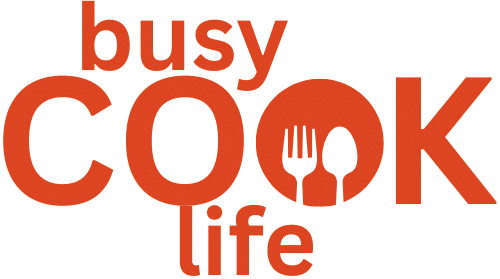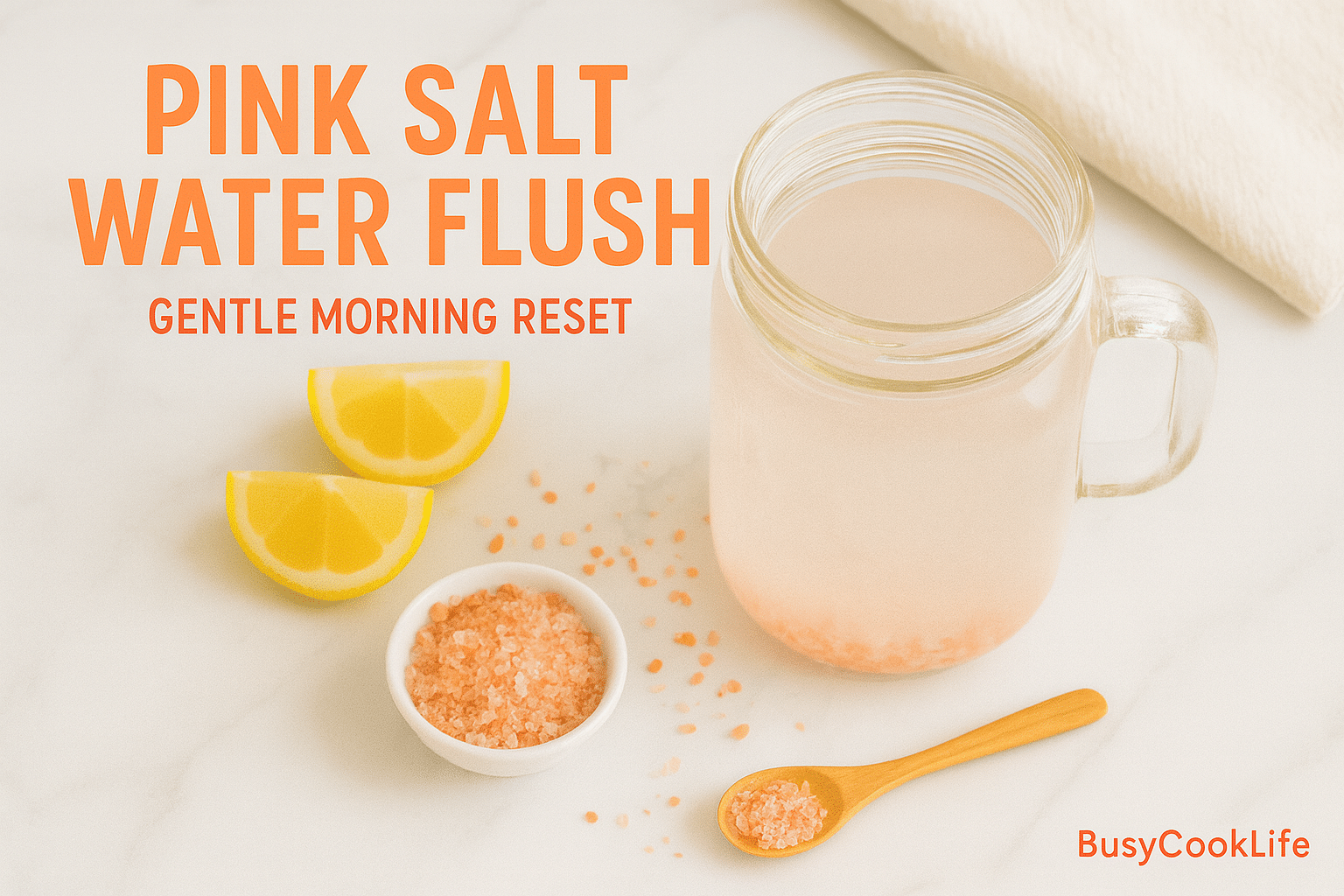One sleepy Asheville morning, I was juggling a fussy toddler and a to-do list that would not quit. I needed a quick reset. So I tried a pink salt water flush—simple, homey, and honest.
I sip warm water, drink it fast, and wait. Within an hour my body wakes up and so do I. It’s not glam. It’s practical. It gives me a clear window to breathe and plan the day.
I’ll share a friendly how-to guide, safety-first notes, and easy aftercare that fits busy life. I’m clear: this supports bowel movements short-term; it’s not a cure-all or a miracle detox. Stay near a bathroom and listen to your body.
If you’re curious, I walk readers step-by-step in my kitchen routine over at my recipe page—see the simple method here: my quick guide. Promise: gentle tips, troubleshooting, and cozy follow-up for real people.
Key Takeaways
- Short ritual that can wake you up and move your bowels within an hour.
- Simple ingredients and a fast drink—plan your time and stay nearby.
- Helps short-term bowel movements; not a medical detox.
- Safety matters—know who should skip it and when to pause.
- My upcoming how-to guide includes troubleshooting and gentle aftercare.
Why my morning pink salt water flush became a cozy ritual
After a night of bad takeout and a toddler wake-up call, I needed a tiny, fast reset. I tried a simple salt water routine on an empty stomach. It felt honest and doable.
The morning I needed a reset
So here’s how I do it: I warm a mug, stir in the measured salt, and sip it down like pressing a reset button. I stay close to the bathroom, and give myself quiet time to breathe.
What I feel within minutes
Within minutes there’s a gentle heat in my belly and a lightness that feels like my body is finally paying attention. Some mornings are quick. Some take longer. I keep it gentle and listen to my body.
A simple, budget-friendly reboot
This ritual sticks because it’s cheap, zero gadgets, and five calm minutes before chaos. It gives me steadier energy, less bloat, and a calmer start. If you want the exact method I use in my kitchen, see my quick guide: my quick guide.
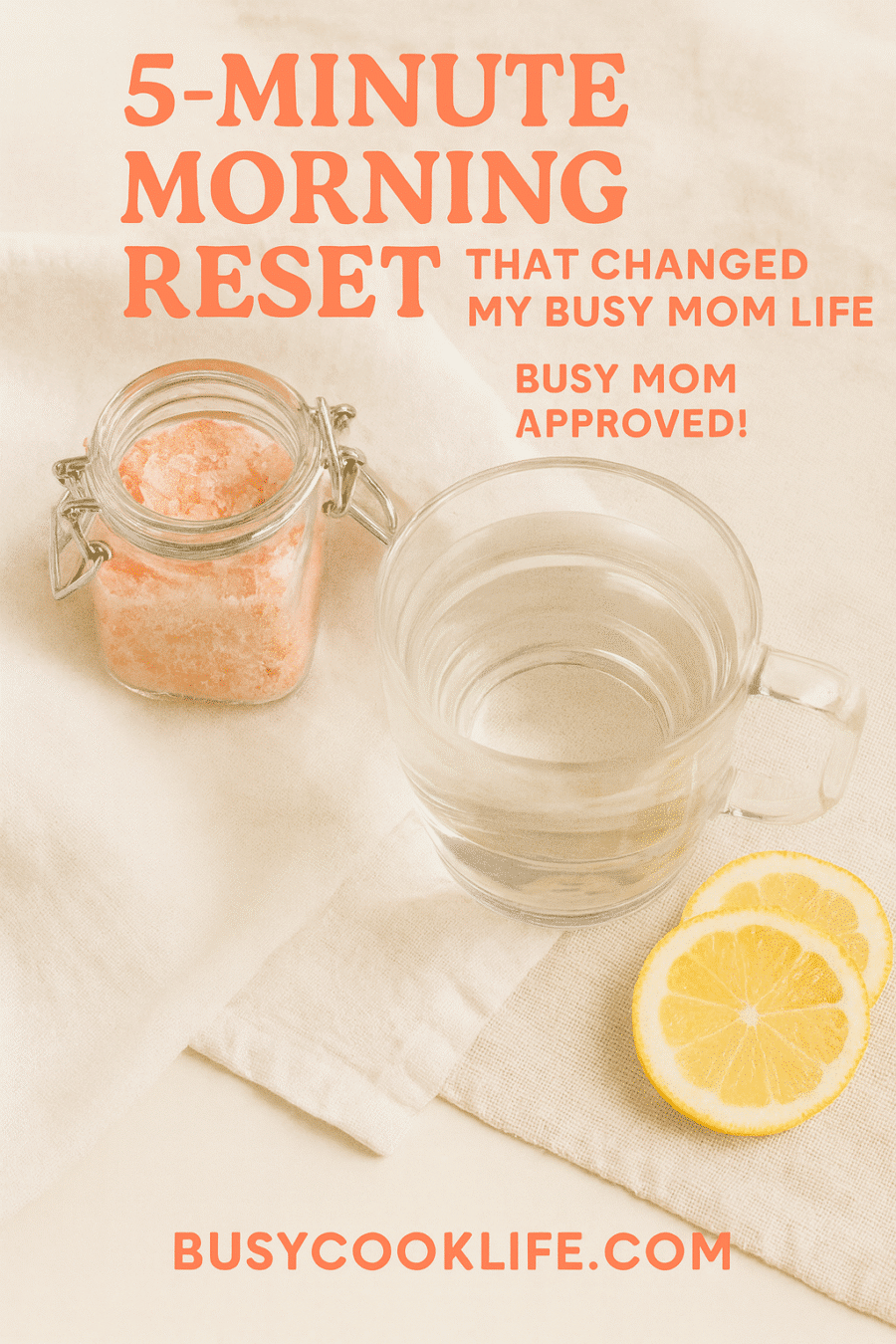
Salt water flush basics: what it is, how it works, and what the science says
I keep a plain, old‑school drink on hand to get my system moving. It’s a simple at‑home mixture I make on an empty stomach.
What’s in the cup: dissolve 2 tsp non‑iodized sea salt—think pink himalayan or a good gray sea variety—in 1 quart (4 cups) or 1 liter of warm water. Add a squeeze of lemon for taste if you like. Drink it quickly and stay near a bathroom.
How it actually works
The salty, hyperosmolar mix draws fluid into the digestive tract by osmosis. That extra fluid softens stool and increases volume. The colon responds with peristalsis—a gentle wave of movement—and that usually leads to bowel movements in 30–60 minutes.
The science and the limits
People report short‑term colon cleansing after this routine. That said, there’s no solid evidence that it removes systemic toxins or cures parasite issues. Respect curiosity, but keep expectations realistic.
- Texture matters: dissolve fully—no gritty bits; it should look cloudy but smooth.
- Types I keep: pink himalayan or a mineral‑rich sea option, non‑iodized by design.
- Plan: clear a morning window, sip fast, and listen to your body—start slow and stop if something feels off.
Pink salt water flush safety first: benefits, limits, and real risks
My rule: know the risks before trying a fast morning reset. I want this ritual to help me, not harm me. Short-term colon movement can happen. Long-term “detox” claims? I stay skeptical.
Short-term effects vs. long-term claims
What I notice: the immediate effect is usually a quick bowel movement. That’s a short-term outcome, not proof of systemic detox. Science doesn’t back broad cleanse promises, so I treat this as a situational tool — not a regular habit.
Who should skip it
I skip this if I have high blood pressure, kidney disease, heart concerns, or active GI disease. Pregnant or nursing? I avoid it. If you take meds or have chronic illness, talk to a provider first.
Possible side effects
Common side effects include cramping, nausea, bloating, dehydration, and electrolyte imbalance. Too much sodium can raise blood pressure and stress your system. Warning signs: dizziness, palpitations, confusion, or muscle weakness — stop and seek care.
How I minimize risk
I do this on an empty stomach and plan a clear morning window. I sip quickly, stay near a bathroom, and hydrate slowly afterward. I keep an oral rehydration option nearby and rest if I feel off.
“Your health first — no ritual is worth risking a serious reaction.”
For my exact, careful method and timing, see my quick guide: simple recipe and tips. I use this only occasionally — never daily — and I check in with my doctor when needed.
How to do a pink salt water flush step by step
I get my jar ready the night before so morning chaos doesn’t wreck the plan. A little prep saves time and stress.
Ingredients and tools I set out:
Prep the night before
I place 2 tsp non‑iodized sea salt, a clean jar with lid, a big glass, and a lemon on the counter. That way I can move fast when the day starts.
Mixing until no grit remains
I heat warm water so it’s cozy to the touch, not hot. I add the salt and shake the jar hard until the mixture looks cloudy and smooth. A splash of lemon juice helps the taste.
Drink fast, then belly massage
I drink it in under five minutes on an empty stomach. Then I lie on my side a few minutes and do a gentle circular belly massage. It helps the whole process along.
Timing and safety
Do this in the morning or a few hours after your last meal. Expect the urge within minutes to about an hour. Stay home for a few hours and keep a light snack and fluids ready.
“Your health first — no ritual is worth risking a serious reaction.”
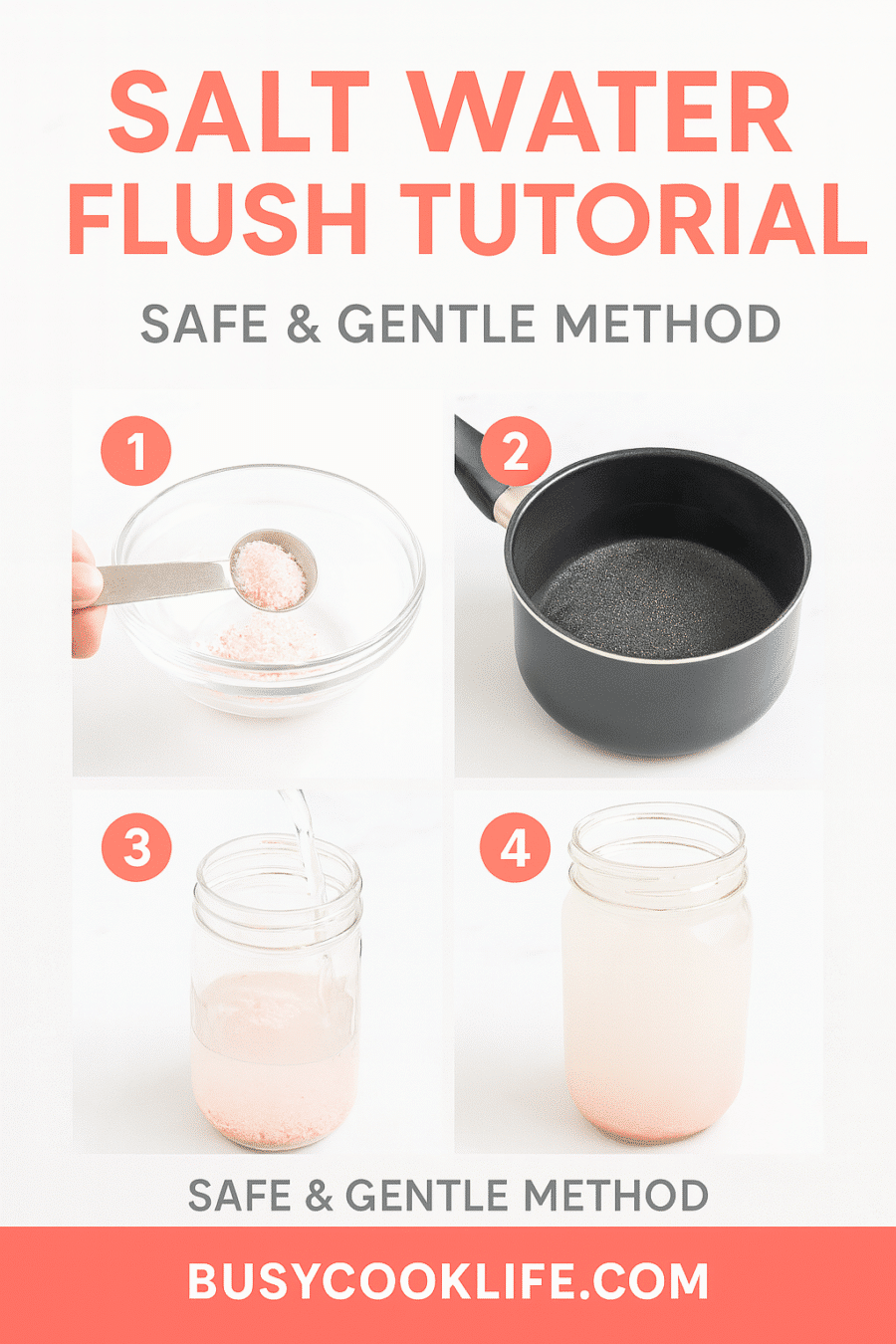
When the salt water flush doesn’t “flush”: fixes that help
When the mix doesn’t prompt movement, I stay calm and treat it like a mini troubleshooting job. A missed morning is not a failure—just data. I use a few quick checks to find what to change.
Adjusting dose, temperature, and sipping speed
Tweak the dose. Too little or too much can stall results. I change the amount in tiny steps until it feels right.
Mind the temp. Warm water works better for me than cool. It soothes the gut and encourages motion.
Drink fast. Finishing quickly often helps more than slow sipping. A quick finish can trigger peristalsis within minutes.
Empty stomach, posture, and when to try again
Make sure you’re truly on an empty stomach. Waiting another hour can make a big difference.
Lie on your side and massage your belly in gentle circles. This one’s saved my week more than once.
Some people don’t respond the first time. Try again another morning, adjust timing, and keep expectations kind.
- I double‑check my salt type—non‑iodized sea salt only.
- I support stubborn constipation with extra fluids, fiber, and light movement.
- If the bowel still resists, I pause and consult a pro before repeating a water flush.
“Small tweaks beat stress—listen to your body and try one change at a time.”
Aftercare that actually helps: gut support and smarter alternatives
So here’s what I do next: quick rehydration, small food, and easy movement. After any cleanse, the first job is to settle your system and restore balance.
Rehydrate, restore electrolytes, and add a probiotic
I sip plain fluids with a pinch of easy electrolytes and rest for a bit. Rehydration helps the body replace what it lost and calms cramps.
I also take a probiotic or eat yogurt or fermented veggies. That helps repopulate the microbiome and supports the digestive tract.
Fiber-forward meals to keep things moving without a flush
Later I choose a gentle, fiber-forward breakfast—oats with berries, a bean salad, or whole-grain toast and fruit. Fiber helps prevent constipation long term.
Think soluble and insoluble fiber together—beans, oats, veggies, and some fruit—so the colon gets steady, natural bulk.
Everyday habits that support liver and kidney detox pathways
I focus on a balanced diet, regular movement, and less alcohol. Small daily choices help the liver and kidneys do their job without extreme fixes.
Cleaner home products and not smoking also lower the load of toxins on the body over time.
Alternatives to a salt water flush: gentle, evidence-aligned options
If I need help but want safer options, I try a fiber boost, magnesium supplements (after checking with my doc), or a short, gentle laxative under guidance. I skip juice fasts and detox teas—many lack evidence and can backfire.
“Small, steady habits beat dramatic cleanses—your body thanks you for kindness and time.”
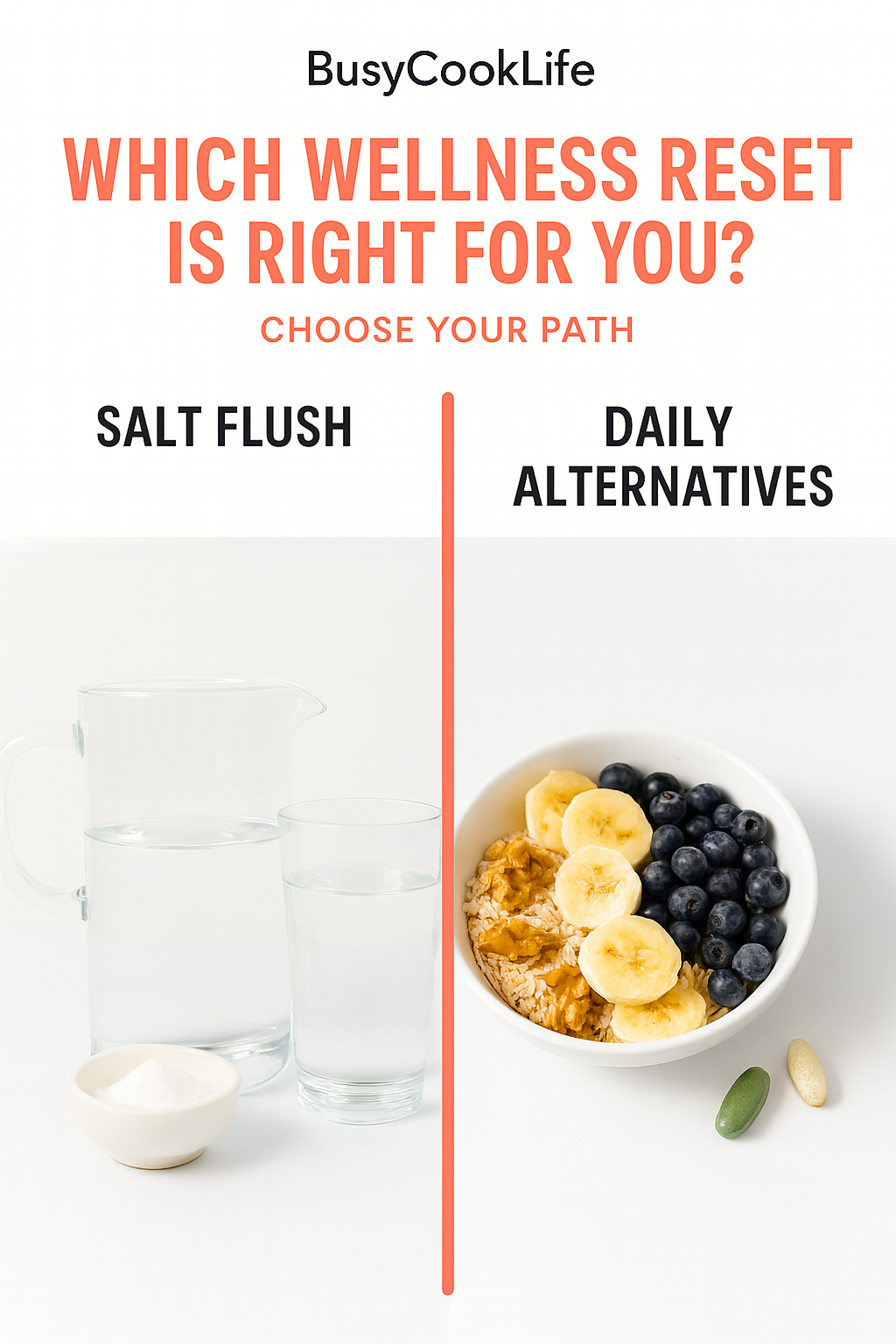
- I sip fluids, add gentle electrolytes, and rest before a big meal.
- I reach for probiotics—yogurt, kefir, or fermented veggies.
- I build fiber plates so I don’t rely on a water flush for regularity.
- I support natural detox with good diet, movement, and cleaner products.
How I weave a pink salt water flush into real life (and toddler chaos)
I carve out a quiet window before breakfast and treat it like a little health reset. My toddler gets a show-and-tell cup, I grab ten calm minutes, and I move deliberately so the rest of the morning stays smooth.
My calm-morning routine and quick breakfasts
I plan the ritual on an empty stomach and block off a few hours at home. Expect urgent trips to the toilet for up to a few hours—so no errands and no workouts. I keep the day light and intentional.
Quick practical steps:
- I choose a quiet window—ten minutes to myself so I’m not racing the clock.
- I line up a simple breakfast, like a cozy mug recipe from BusyCookLife.com’s cozy mug recipes, so the kid and I eat fast and warm.
- I plan a few hours at home, hydrate slowly afterward, and avoid heavy, super-sweet juice right away.
I ask my partner or a neighbor to know that people in the house might need quiet space. Communication helps—no surprise bathroom scrambles.
“Calm routines make messy mornings feel manageable.”
| Plan | Action | Why it helps |
|---|---|---|
| Ten‑minute window | Find a quiet spot, sip fast, rest | Reduces stress and fits toddler schedules |
| Few hours at home | Skip errands; stay nearby | Allows multiple bowel movements and recovery |
| Simple post-care | Hydrate, light meal, short walk | Restores balance and supports long-term health |
| Family check-in | Tell people your plan | Prevents interruptions and eases logistics |

The real benefits I notice: a calmer belly, clearer focus, and a bit more patience for sticky hands and big feelings. I listen to my body—rest when tired, eat when hungry, and skip the ritual when it doesn’t fit the day.
Conclusion
I close the morning ritual with a little rehydration and a quiet minute of rest. I mix carefully, drink on an empty stomach, and plan a clear block of time. That simple routine often prompts bowel movement and a short colon cleanse. But it’s not a cure‑all.
Be mindful of sodium and blood pressure. If you have heart, kidney, or metabolic disease, or you’re pregnant, skip it and ask a provider. A salt water flush can help within minutes for some people, yet it also carries side effects.
Long term, I bet on steady habits: hydrate, eat fiber, move daily, and choose gentle supports over repeated cleanses. Try this once on a calm morning — or opt for a fiber‑forward meal instead.
Your body, your choice. Take care, go slow, and be kind to yourself as you find what works.
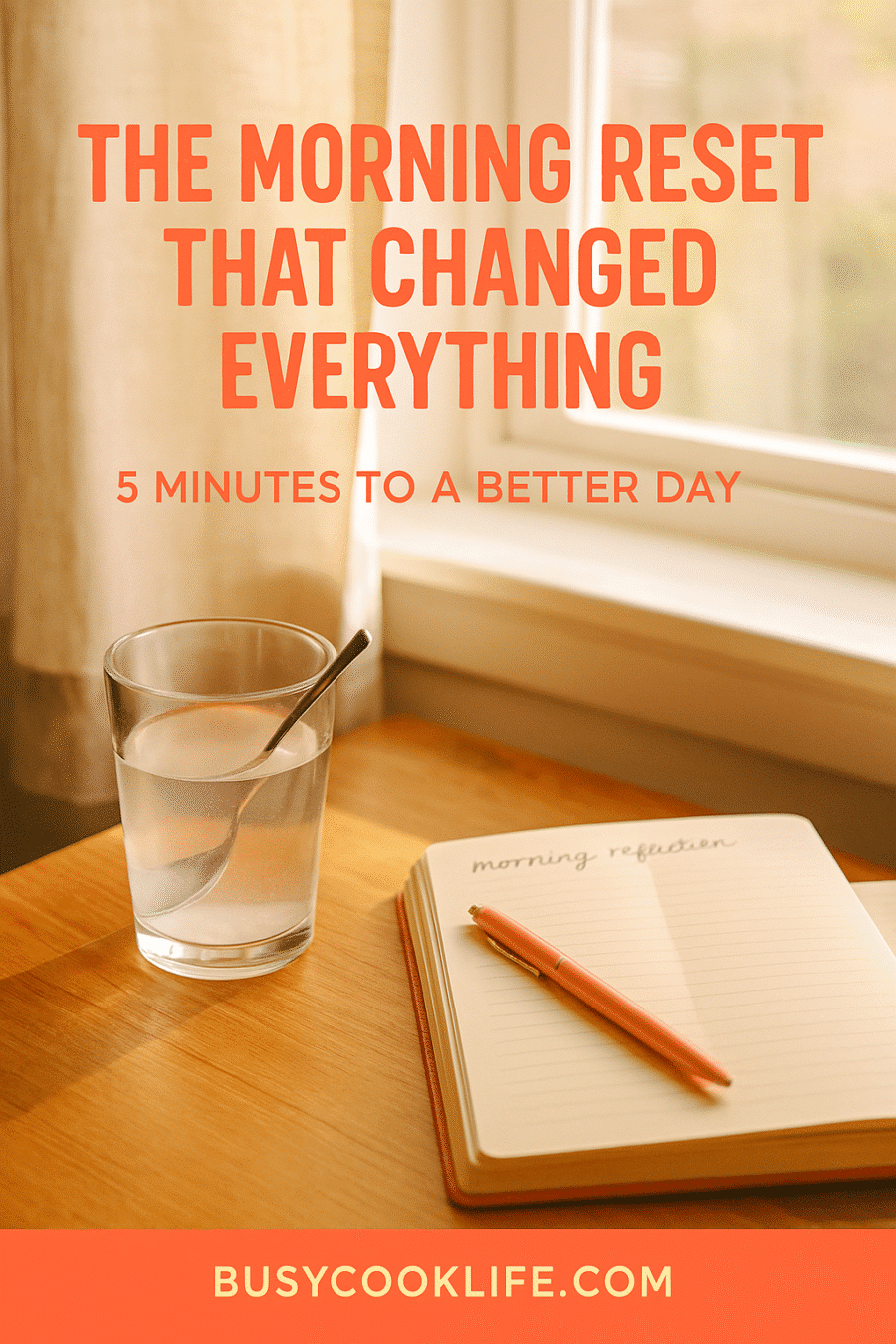
FAQ
How does a pink salt water flush boost my energy?
I notice an energy lift after a flush because the process often clears sluggishness in my digestive tract and reduces bloating. When my gut feels lighter, I move easier and eat fresher foods that keep my blood sugar steadier. That said, the effect is personal — some people feel a pep, others just feel normal. If you have health conditions, check with your clinician first.
Why did my morning pink salt water flush become a cozy ritual?
It started one tired morning when I wanted a simple reset. Doing it on an empty stomach felt calming — like giving my day a tiny, predictable start. The routine, warm drink, and quiet time made it feel more like self-care than a chore.
What did I feel within minutes and why do I stick with it?
Within minutes I often felt mild stomach movement and an urge to go. I stick with it because those quick results mean I can plan the rest of my day without surprise cramps or constipation. It’s fast and low-cost compared with other resets.
Is the pink salt water flush a budget-friendly reboot?
Totally — it’s basically salt and warm water, so it’s cheap. For me, the low cost and ease make it an attractive option when I want a simple digestive reset without spending on supplements or treatments.
What’s in the mix and how should I prepare it?
The classic mix uses warm water and a non-iodized mineral salt like Himalayan or sea salt. I warm the water so it’s comfortable to drink, dissolve the appropriate amount of salt fully, and sip it on an empty stomach.
Why do bowel movements usually follow — what’s the science?
The saline solution increases fluid in the intestines and triggers peristalsis — that wave-like muscle movement that pushes waste out. Osmosis draws water into the gut, which helps soften stool and speed transit. It’s a mechanical effect rather than a magic detox.
What are the short-term effects versus long-term claims?
Short-term you may get rapid bowel movements, less bloating, or mild cramping. Long-term “detox” claims lack strong evidence — the liver and kidneys do most of the real detoxing. Frequent flushing can cause electrolyte problems if done too often.
Who should skip this flush?
People with high blood pressure, heart disease, kidney issues, GI disease, or those who are pregnant should avoid it unless their doctor says it’s safe. The salt load and fluid shifts can be risky for those groups.
What possible side effects should I watch for?
Cramping, nausea, dizziness, dehydration, and electrolyte imbalances can happen. If you feel faint, very weak, or have a racing heart, stop and seek medical advice. Listen to your body — and hydrate afterward.
How do I minimize risks when I try it?
I do it on an empty stomach, pick a morning when I can stay home, use moderate salt, and follow with plain fluids and a light, salty snack if needed. I also avoid doing it more than occasionally and stop if I feel off.
What ingredients and tools do I set out the night before?
I lay out a mug, a kettle for warm water, and a measured spoon of non-iodized mineral salt. That little prep makes the morning quick — no scrambling for things when you’ve got sleepy kids or a commute.
Any tips for mixing so no gritty bits linger?
Stir well until the salt fully dissolves. Using slightly warmer water and a spoon with a good edge helps. If you hate grit, strain through a fine mesh or dissolve the salt in a small amount of hot water first, then add the rest.
How fast should I drink it and what about belly massage?
Drink it fairly quickly — not gulping, but steady. I usually finish in a few minutes, then lie down and gently massage my belly clockwise. The massage seems to nudge things along without extra effort.
What’s the typical timing — morning versus evening?
Morning is my go-to because I can stay close to home for the “within minutes to an hour” window when bowel movements commonly occur. Evening can work, but be ready for wake-ups. I avoid doing it before long outings.
How should I plan bathroom breaks?
Stay home, bring a book or phone, and expect several trips in a short span. Hydrate afterward. For me, planning a relaxed morning avoids stress and messy surprises.
What if the flush doesn’t “flush” — how do I fix it?
Try small adjustments: a tiny extra pinch of salt, a slightly warmer temperature, or sipping a bit faster. Make sure your stomach is empty. If it still doesn’t work, don’t force it — try again another day or consider gentler options like fiber.
How does posture or empty stomach affect success?
An empty stomach is key — food delays the effect. Sitting upright or taking a short walk after drinking can help move things along. Lying flat often slows the process.
What aftercare helps recovery and gut health?
Rehydrate with plain fluids or an electrolyte drink, eat a fiber-rich breakfast, and consider a probiotic to support balance. I go for soups, oats, or a smoothie — gentle, nourishing choices that keep things steady.
What fiber-forward meals do I recommend to avoid frequent flushing?
Oatmeal with fruit, beans in a salad, roasted veggies, and whole-grain toast do the trick. These meals support regularity so you don’t rely on a flush every time.
Which everyday habits support liver and kidney detox pathways?
Simple things: steady hydration, balanced meals, less processed food, and regular movement. Sleep and stress management matter too — your organs tidy up best when you’re not running on empty.
What are gentler, evidence-aligned alternatives to a salt water flush?
Try increased dietary fiber, magnesium citrate (used short-term and under guidance), probiotics, or a scheduled mild laxative if needed. These options are often safer for regular use.
How do I weave this flush into real life with toddlers and chaos?
I pair it with a slow start: set up a play area, make a warm drink, and keep a helper snack on hand. Quick breakfasts like BusyCookLife.com’s cozy mug recipes work great — fast, filling, and kid-approved.
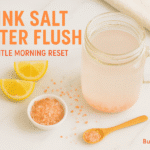
How a Pink Salt Water Flush Boosts My Energy
- Prep Time: 5
- Total Time: 5
- Yield: 1 serving 1x
- Category: Wellness Drinks
- Method: No-Cook
- Cuisine: Wellness
Description
A gentle morning wellness drink using pink himalayan salt and warm water to support natural bowel movements. Perfect for busy parents seeking a quick, natural reset before starting their day.
Ingredients
2 teaspoons non-iodized sea salt (pink Himalayan or gray sea salt)
1 quart (4 cups) warm water, comfortable drinking temperature
1 fresh lemon wedge (optional, for taste)
Extra water for rehydration afterward
Instructions
1. Heat water until warm and comfortable to drink, not hot
2. Add 2 teaspoons of non-iodized sea salt to warm water
3. Stir or shake vigorously until salt completely dissolves and mixture looks cloudy but smooth
4. Optional: Add a squeeze of fresh lemon for better taste
5. Drink the entire mixture quickly within 5 minutes on an empty stomach
6. Lie on your side and gently massage your belly in clockwise circles for 2-3 minutes
7. Stay close to bathroom facilities for the next 1-2 hours
8. Expect bowel movements within 30-60 minutes
9. Rehydrate slowly with plain water afterward
10. Rest and have a light, gentle breakfast when ready
Notes
SAFETY FIRST: This is not suitable for pregnant women, people with high blood pressure, kidney disease, heart conditions, or active GI issues. Consult your healthcare provider if you have any medical conditions.
TIMING: Do this on an empty stomach, preferably in the morning when you can stay home for 2-3 hours.
FREQUENCY: Use occasionally only, never daily. This supports short-term bowel movements but is not a cure-all or medical detox.
TROUBLESHOoting: If no results occur, try slightly warmer water, drink faster, or ensure stomach is completely empty. Don’t repeat more than once in a day.
PIN THIS RECIPE: Save to your Pinterest wellness boards for easy access!
FOLLOW BUSYCOOKLIFE: For more gentle wellness tips that work for busy families.
Nutrition
- Serving Size: 1
- Calories: 0
- Sugar: 0g
- Sodium: 4600mg
- Fat: 0g
- Saturated Fat: 0g
- Unsaturated Fat: 0g
- Trans Fat: 0g
- Carbohydrates: 0g
- Fiber: 0g
- Protein: 0g
- Cholesterol: 0mg
